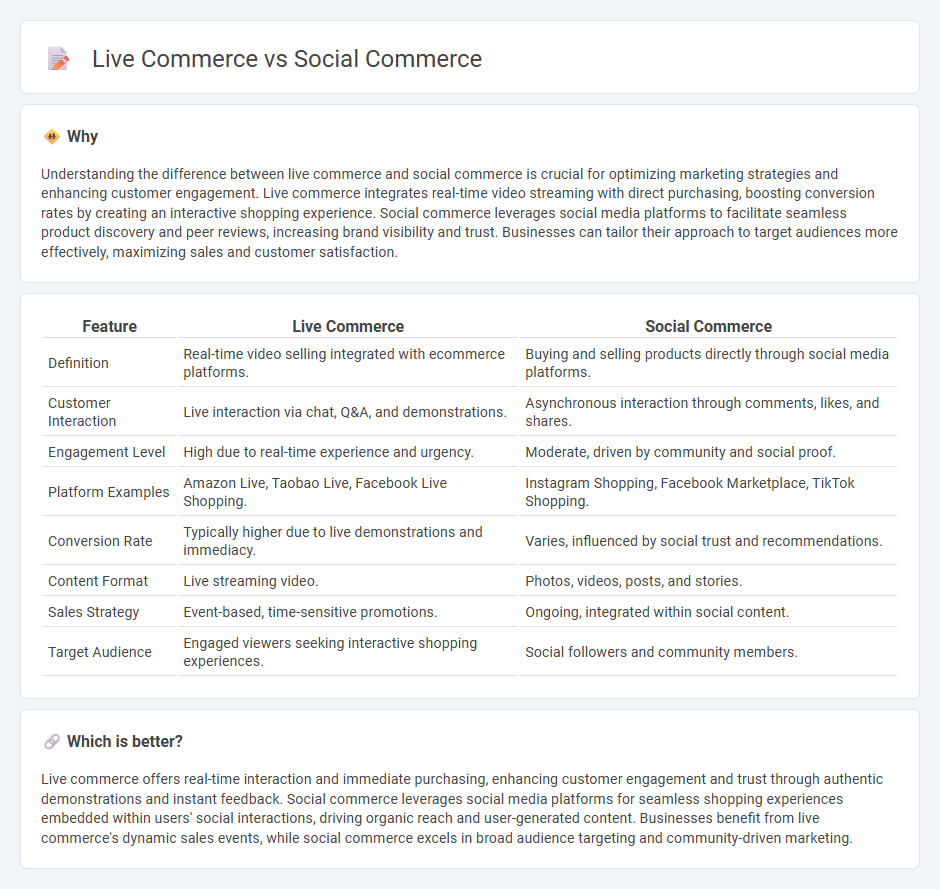
Live commerce integrates real-time video streaming with instant purchasing options, enhancing customer engagement and driving immediate sales. Social commerce leverages social media platforms to facilitate direct buying experiences through user-generated content, reviews, and peer recommendations. Explore how live commerce and social commerce are revolutionizing online retail strategies and consumer interactions.
Why it is important
Understanding the difference between live commerce and social commerce is crucial for optimizing marketing strategies and enhancing customer engagement. Live commerce integrates real-time video streaming with direct purchasing, boosting conversion rates by creating an interactive shopping experience. Social commerce leverages social media platforms to facilitate seamless product discovery and peer reviews, increasing brand visibility and trust. Businesses can tailor their approach to target audiences more effectively, maximizing sales and customer satisfaction.
Comparison Table
| Feature | Live Commerce | Social Commerce |
|---|---|---|
| Definition | Real-time video selling integrated with ecommerce platforms. | Buying and selling products directly through social media platforms. |
| Customer Interaction | Live interaction via chat, Q&A, and demonstrations. | Asynchronous interaction through comments, likes, and shares. |
| Engagement Level | High due to real-time experience and urgency. | Moderate, driven by community and social proof. |
| Platform Examples | Amazon Live, Taobao Live, Facebook Live Shopping. | Instagram Shopping, Facebook Marketplace, TikTok Shopping. |
| Conversion Rate | Typically higher due to live demonstrations and immediacy. | Varies, influenced by social trust and recommendations. |
| Content Format | Live streaming video. | Photos, videos, posts, and stories. |
| Sales Strategy | Event-based, time-sensitive promotions. | Ongoing, integrated within social content. |
| Target Audience | Engaged viewers seeking interactive shopping experiences. | Social followers and community members. |
Which is better?
Live commerce offers real-time interaction and immediate purchasing, enhancing customer engagement and trust through authentic demonstrations and instant feedback. Social commerce leverages social media platforms for seamless shopping experiences embedded within users' social interactions, driving organic reach and user-generated content. Businesses benefit from live commerce's dynamic sales events, while social commerce excels in broad audience targeting and community-driven marketing.
Connection
Live commerce integrates real-time video streaming with e-commerce platforms, allowing consumers to interact directly with sellers while shopping. Social commerce leverages social media networks to facilitate buying and selling through user-generated content, reviews, and influencer endorsements. Both models enhance consumer engagement and trust by combining social interaction with seamless online purchasing experiences.
Key Terms
User Engagement
Social commerce integrates shopping features directly into social media platforms, enhancing user engagement through interactive content like posts, stories, and personalized recommendations. Live commerce intensifies this interaction by providing real-time video streams where consumers can engage with hosts, ask questions, and make instant purchases, significantly boosting impulse buying and active participation. Explore more to understand how these dynamic shopping experiences drive user engagement and sales growth.
Real-time Interaction
Social commerce integrates shopping experiences within social media platforms, enabling users to discover and purchase products through shared content and peer interactions. Live commerce enhances this model by incorporating real-time video broadcasts where hosts engage directly with viewers, showcasing products and answering questions instantaneously. Explore how real-time interaction shapes consumer behavior and drives sales in social and live commerce trends.
Platform Integration
Social commerce seamlessly integrates shopping features within social media platforms like Instagram, Facebook, and TikTok, enabling users to discover and purchase products without leaving the app. Live commerce combines real-time video streaming with interactive shopping experiences on platforms such as Taobao Live and Amazon Live, fostering immediate consumer engagement and impulse buying. Explore detailed comparisons of platform integration strategies to enhance your digital retail approach.
Source and External Links
Social commerce - Wikipedia - Social commerce is the use of social networks in e-commerce transactions from browsing to checkout, allowing users to complete purchases without leaving the social media platform.
What is social commerce? - TechTarget - Social commerce leverages social networks like Facebook, TikTok, and Instagram to enable businesses to market and sell products directly through the platforms, using algorithms and data insights to personalize and streamline the shopping experience.
Social Commerce 101: Examples, Platforms & Tips - Square - Social commerce combines marketing and direct sales through social profiles, enabling consumers to discover, browse, and purchase products seamlessly within social media apps, reducing friction and boosting engagement.
 dowidth.com
dowidth.com